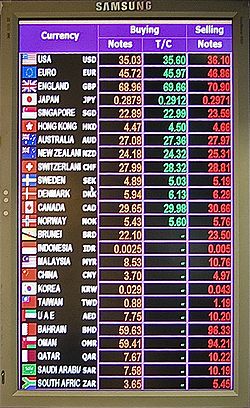An exchange rate between two currencies is the rate at which one currency will be exchanged for another.
Learning Objectives
Describe how economic forces influence exchange rates
Key Takeaways
Key Points
- An exchange rate between two currencies is the rate at which one currency will be exchanged for another. It is also regarded as the value of one country’s currency in terms of another currency.
- Quotes using a country’s home currency as the price currency are known as direct quotation. Quotes using a country’s home currency as the unit currency are known as indirect quotation. Using direct quotation, if the home currency is strengthening, then the exchange rate number decreases.
- There are many factors that impact exchange rates, such as inflation, interest rates, balance of payments, and government policy.
Key Terms
- arbitrage: Any market activity in which a commodity is bought and then sold quickly, for a profit which substantially exceeds the transaction cost
- balance of payment: an accounting record of all monetary transactions between a country and the rest of the world. These transactions include payments for the country’s exports and imports of goods, services, financial capital, and financial transfers. The BoP accounts summarize international transactions for a specific period, usually a year, and are prepared in a single currency, typically the domestic currency for the country concerned.
- Interest rate parity: a no-arbitrage condition representing an equilibrium state under which investors will be indifferent to interest rate available on bank deposits in two countries.
In finance, an exchange rate (also known as the foreign-exchange rate, forex rate, or FX rate) between two currencies is the rate at which one currency will be exchanged for another. It is also regarded as the value of one country’s currency in terms of another currency. For example, an interbank exchange rate of 91 Japanese yen (JPY ¥) to the United States dollar (US $) means that ¥91 will be exchanged for each US $1 or that US $1 will be exchanged for each ¥91.

Quotes using a country’s home currency as the price currency (e.g., EUR 0.735342 = USD 1.00 in the eurozone) are known as direct quotation or price quotation (from that country’s perspective) and are used by most countries.
Quotes using a country’s home currency as the unit currency (e.g., EUR 1.00 = USD 1.35991 in the eurozone) are known as indirect quotation or quantity quotation and are used in British newspapers and are also common in Australia, New Zealand, and the eurozone.
Using direct quotation, if the home currency is strengthening (i.e., appreciating, or becoming more valuable), the exchange rate number decreases. Conversely, if the foreign currency is strengthening, the exchange rate number increases and the home currency is depreciating.
A market based exchange rate will change whenever the values of either of the two component currencies change. A currency will tend to become more valuable whenever demand for it is greater than the available supply. It will become less valuable whenever demand is less than available supply (this does not mean people no longer want money, it just means they prefer holding their wealth in some other form, possibly another currency).
Factors that Impact Exchange Rates
There are many factors that impact exchange rates, such as inflation, interest rates, balance of payments, and government policy.
Inflation deteriorates the purchasing power of a currency. As there is high inflation, the demand for the currency will go down. Decreased demand for a currency makes the price of it will drop. In other words, the currency will depreciate. This is presented by a higher exchange rate if the exchange rate is quoted as home currency / 1 foreign currency.
Uncovered interest rate parity states that an appreciation or depreciation of one currency against another currency might be neutralized by a change in the interest rate differential. If US interest rates increase while Japanese interest rates remain unchanged, the US dollar should depreciate against the Japanese yen by an amount that prevents arbitrage. In sum, if other things remain unchanged, one currency will appreciate or depreciate if interest rates in the country increase or decrease.
Exchange rates can also be affected by the balance of payment. The balance of payment model holds that a foreign exchange rate must be at its equilibrium level, which is the rate which produces a stable current account balance. A nation with a trade deficit will experience a reduction in its foreign exchange rate reserves, which ultimately lowers (depreciates) the value of its currency. The cheaper currency renders the nation’s goods (exports) more affordable in the global marketplace while making imports more expensive. After an intermediate period, imports are forced down and exports rise, thus stabilizing the trade balance and the currency toward equilibrium.
Countries may gain an advantage in international trade if they manipulate the value of their currency by artificially keeping its value low, typically by the national central bank engaging in open market operations. It is argued that the People’s Republic of China has succeeded in doing this over a long period of time. In 2010, other nations, including Japan and Brazil, attempted to devalue their currency in the hopes of subsidizing cheap exports and bolstering their ailing economies. A low exchange rate lowers the price of a country’s goods for consumers in other countries but raises the price of goods, especially imported goods, for consumers in the manipulating country.
Licenses and Attributions
CC licensed content, Shared previously
- Curation and Revision. Provided by: Boundless.com. License: CC BY-SA: Attribution-ShareAlike
CC licensed content, Specific attribution
- Exchange rate. Provided by: Wikipedia. License: CC BY-SA: Attribution-ShareAlike
- Interest rate parity. Provided by: Wikipedia. License: CC BY-SA: Attribution-ShareAlike
- balance of payment. Provided by: Wikipedia. License: CC BY-SA: Attribution-ShareAlike
- arbitrage. Provided by: Wikipedia. License: CC BY-SA: Attribution-ShareAlike
- Exchange rate. Provided by: Wikipedia. License: Public Domain: No Known Copyright

